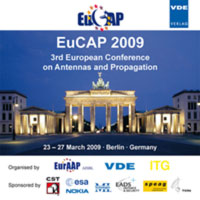Short-term prediction of atmospheric attenuation in Q band from ka-band measurements on Earth-to-Satellite links
Conference: EuCAP 2009 - 3rd European Conference on Antennas and Propagation
03/23/2009 - 03/27/2009 at Berlin, Germany
Proceedings: EuCAP 2009
Pages: 4Language: englishTyp: PDF
Personal VDE Members are entitled to a 10% discount on this title
Authors:
Montera, L. De; Barthes, L.; Gole, P.; Mallet, C. (CETP,10-12 avenue de l'europe, 78140 VELIZY, France)
Marsault, T. (DGA CELAR, B.P. 7, 35 998 Rennes Armées, France)
Abstract:
Fade Mitigation Techniques on Earth – satellite links require the estimation of channel propagation conditions. This is generally done by using downlink measurements at a lower frequency to derive the channel uplink propagation conditions at higher frequencies. Moreover, when atmospheric conditions are changing, the ground stations have to change their own configuration (increase or decrease transmit power and/or data rates for example). These changes involve estimating the uplink propagation conditions in advance. The proposed algorithm allows the margin to be estimated a few seconds in advance from the downlink so that a given percentage of availability of the uplink is reached. For that purpose, we have used a recently developed prediction method based on an ARMA/GARCH model (de Montera et al., 2008) and scaling frequency models. From the downlink attenuation, first the attenuation is first predicted with a prediction horizon ranging between 2 and 30 seconds. The contributions of gases, clouds and rain are then estimated using a neural network (Barthes et al., 2006) and scaled using specific scaling factors. Finally, the attenuation and its variance for the uplink are estimated and the margin is derived. This algorithm allows an accurate upper-bound of the future attenuation to be estimated in real time, which minimizes the cost of Fade Mitigation Techniques and therefore enables the communication system to reach an appropriate percentage of availability. After a presentation of the method, we describe results obtained from the Syracuse 3 EHF measurements (20/44 GHz). We show that the method gives good results for a prediction horizon in the range 2 – 30 seconds. We conclude the paper by showing that for a prediction horizon of 10 seconds and for attenuations greater than 5 dB the error due to frequency scaling is larger than the prediction error, so that future improvements should focus on scaling frequency models.


